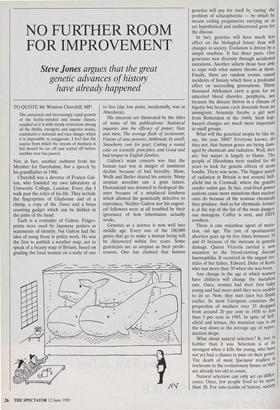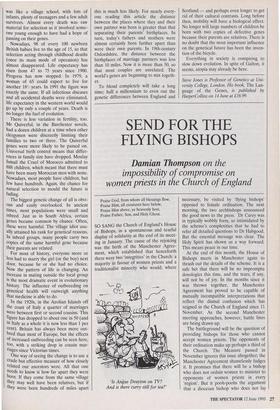NO FURTHER ROOM FOR IMPROVEMENT
Steve Jones argues that the great
genetic advances of history have already happened
TO QUOTE Mr Winston Churchill, MP:
The unnatural and increasingly rapid growth of the feeble-minded and insane classes, coupled as it is with steady restriction among all the thrifty, energetic and superior stocks, constitutes a national and race danger which it is impossible to exaggerate. I feel that the source from which the stream of madness is fed should be cut off and sealed off before another year has passed.
Not, in fact, another outburst from the Member for Davyhulme, but a speech by his grandfather in 1906.
Churchill was a devotee of Francis Gal- ton, who founded my own laboratory at University College, London. Every day I walk past the relics of his life. They include the fingerprints of Gladstone and of a chimp, a copy of the Times and a brass counting gadget which can be hidden in the palm of the hand.
Each is a reminder of Galton. Finger- prints were used by Japanese potters as statements of identity, but Galton had the idea of using them in police work. He was the first to publish a weather map, not to speak of a beauty map of Britain, based on grading the local women on a scale of one to five (the low point, incidentally, was in Aberdeen).
His interests are illustrated by the titles of some of his publications: Statistical inquiries into the efficacy of prayer; Nuts and men; The average flush of excitement; Visions of sane persons; Arithmetic by smell; Strawberry cure for gout; Cutting a round cake on scientific principles; and Good and bad temper in English families.
Galton's main concern was that the human race was in danger of imminent decline because of bad heredity. Shaw, Wells and Butler shared his anxiety. Many utopian novelists saw a grim future. Humankind was doomed to biological dis- aster because of a misplaced kindness which allowed the genetically defective to reproduce. Neither Galton nor his eugeni- cal followers were at all troubled by their ignorance of how inheritance actually works.
Genetics as a science is now well into middle age. Every one of the 100,000 genes that go to make a human being will be discovered within five years. Some geneticists are as utopian as their prede- cessors. One has claimed that human genetics will pay for itself by 'curing' the problem of schizophrenia — by which he means ending pregnancies carrying an as yet hypothetical and undiscovered gene for the disease.
In fact, genetics will have much less effect on the biological future than will changes in society. Evolution is driven by a simple machine. It has three parts. One generates new diversity through accidental mutations. Another selects those best able to cope with what nature throws at them. Finally, there are random events: casual incidents of history which have a profound effect on succeeding generations. Thirty thousand Afrikaners carry a gene for an inherited blood disorder, porphyria, not because the disease thrives in a climate of bigotry but because each descends from an immigrant, Ariaantje Jacobs, a girl sent from Rotterdam in the 1660s. Such hap- hazard changes are much more important in small groups.
What will the genetical utopia be like in, say, the year 3000? Everyone knows, do they not, that human genes are being dam- aged by chemicals and radiation. Well, they are: but nature is largely to blame. The people of Hiroshima were studied for 40 years to look for genetic effects of atom bombs. There was none. The biggest patch of radiation in Britain is not around Sell- afield but in Cornwall, where the granite exudes radon gas. In fact, coal-fired power stations cause more mutations than nuclear ones do because of the noxious chemicals they produce. And as for chemicals, lettuce is at the top of the list of the most danger- ous mutagens. Coffee is next, and DDT nowhere.
There is one relentless agent of muta- tion, old age. The rate of spontaneous abortion goes up by five times between 35 and 45 because of the increase in genetic damage. Queen Victoria carried a new mutation to the blood-clotting disease haemophilia. It occurred in the august tes- ticles of her father, Edward, Duke of Kent, who was more than 50 when she was born.
Any change in the age at which women have children will change the mutation rate. Once, women had their first baby young and had more until they were unable to do so. Now, they start later but finish earlier. In most European countries the proportion of mothers over 35 dropped from around 20 per cent in 1950 to less than 5 per cent in 1985. In spite of Sell- afield and lettuce, the mutation rate is on the way down as the average age of repro- duction drops. What about natural selection? It, too, is its strongest than it was. Selection is at strongest when it kills the young, who have not yet had a chance to pass on their genes.
I The death of most Spectator readers s irrelevant to the evolutionary future as they are already too old to count. Natural selection can only act on differ' ences. Once, few people lived to be more than 20. For nine-tenths of history, society was like a village school, with lots of infants, plenty of teenagers and a few adult survivors. Almost every death was raw material for selection as it involved some- one young enough to have had a hope of passing on their genes.
Nowadays, 98 of every 100 newborn British babies live to the age of 15, so that selection acting through childhood deaths (once its main mode of operation) has almost disappeared. Life expectancy has risen from 47 to 75 years since 1900. Progress has now stopped. In 1979, a woman of 65 could expect to live for another 18"2 years. In 1991 the figure was exactly the same, If all infectious diseases and all accidental deaths were eliminated, life expectancy in the western world would go up by only a couple of years. Death is no longer the fuel of evolution.
There is less variation in fertility, too. Mr Quiverful, in the Barchester novels, had a dozen children at a time when other clergymen were discreetly limiting their families to two or three. The Quiverful genes were more likely to be passed on. Universal birth control means that differ- ences in family size have dropped. Moulay Ismail the Cruel of Morocco admitted to 888 children, which meant that there must have been many Moroccan men with none. Nowadays, most people have children, but few have hundreds. Again, the chance for natural selection to mould the future is fading.
The biggest genetic change of all is obvi- ous and easily overlooked. In ancient times, most populations were small and Inbred. Just as in South Africa, certain genes became common by chance. Often, these were harmful. The village idiot usu- ally attained his rank for genetical reasons. In inbred groups, many people carry two copies of the same harmful gene because their parents are related.
For most of history, everyone more or less had to marry the girl (or the boy) next door, because he or she had no choice. Now the pattern of life is changing. An increase in mating outside the local group Is the most dramatic event in evolutionary history. The influence of outbreeding on genetical health will outweigh anything that medicine is able to do.
In the 1920s, in the Aeolian Islands off the coast of Italy a quarter of marriages Were between first or second cousins. This figure has dropped to about one in 50 (and In Italy as a whole it is now less than 1 per cent). Britain has always been more out- bred than most of Europe, but the effects of increased outbreeding can be seen here, too, with a striking drop in cousin mar- riages since Victorian times.
One way of seeing the change is to use a crude but effective measure of how closely related our ancestors were. All that one needs to know is how far apart they were born. If they come from the same village they may well have been relatives, but if they were born hundreds of miles apart
this is much less likely. For nearly every- one reading this article the distance between the places where they and their own partner was born is greater than that separating their parents' birthplaces. In turn, today's fathers and mothers were almost certainly born further apart than were their own parents. In 19th-century Oxfordshire, the distance between the birthplaces of marriage partners was less than 10 miles. Now it is more than 50, so that most couples are unrelated. The world's genes are beginning to mix togeth- er.
To blend completely will take a long time; half a millennium to even out the genetic differences between England and Scotland — and perhaps even longer to get rid of their cultural contrasts. Long before then, mobility will have a biological effect. No longer will large numbers of children be born with two copies of defective genes because their parents are relatives. There is no doubt that the most important influence on the genetical future has been the inven- tion of the bicycle.
Everything in society is conspiring to slow down evolution. In spite of Galton, it seems, utopia may already be here.
Steve Jones is Professor of Genetics at Uni- versity College, London. His book, The Lan- guage of the Genes, is published by HarperCollins on 14 June at £16.99.



































































 Previous page
Previous page